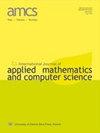具有随机卷客户和分区无限内存缓冲区的排队系统
IF 1.2
4区 计算机科学
Q3 AUTOMATION & CONTROL SYSTEMS
International Journal of Applied Mathematics and Computer Science
Pub Date : 2021-09-01
DOI:10.34768/amcs-2021-0032
引用次数: 2
摘要
摘要本文主要讨论了具有随机容量顾客和分区无限内存缓冲区的排队系统的基本概念。在这样的系统中,到达的顾客被另一个非负随机体积向量表征。向量的指示可以理解为在用户逗留期间位于系统内存空间扇区中的不同类型信息部分的大小。当客户出现在系统中时,此信息不会更改。服务终止后,信息立即离开缓冲区,释放其资源。在分析的模型中,假设顾客的服务时间依赖于他的体积矢量特征,这对总体体积矢量分布有影响。我们研究了三种类型的排队系统:Erlang排队系统、无限排队的单服务器排队系统和平等的处理器共享系统。对于这些模型,我们获得了总体积矢量的拉普拉斯(或拉普拉斯-斯蒂尔杰斯)变换的联合分布函数和所分析的随机矢量的稳态初始混合矩的公式,当存储器缓冲区由两个扇区组成时。我们还计算了一些实际情况下的这些特征,其中客户的服务时间与客户的长度成正比(理解为体积矢量指示的总和)。此外,我们还给出了一些数值计算来说明理论结果。本文章由计算机程序翻译,如有差异,请以英文原文为准。
Queueing Systems with Random Volume Customers and a Sectorized Unlimited Memory Buffer
Abstract In the present paper, we concentrate on basic concepts connected with the theory of queueing systems with random volume customers and a sectorized unlimited memory buffer. In such systems, the arriving customers are additionally characterized by a non-negative random volume vector. The vector’s indications can be understood as the sizes of portions of information of a different type that are located in the sectors of memory space of the system during customers’ sojourn in it. This information does not change while a customer is present in the system. After service termination, information immediately leaves the buffer, releasing its resources. In analyzed models, the service time of a customer is assumed to be dependent on his volume vector characteristics, which has influence on the total volume vector distribution. We investigate three types of such queueing systems: the Erlang queueing system, the single-server queueing system with unlimited queue and the egalitarian processor sharing system. For these models, we obtain a joint distribution function of the total volume vector in terms of Laplace (or Laplace–Stieltjes) transforms and formulae for steady-state initial mixed moments of the analyzed random vector, in the case when the memory buffer is composed of two sectors. We also calculate these characteristics for some practical case in which the service time of a customer is proportional to the customer’s length (understood as the sum of the volume vector’s indications). Moreover, we present some numerical computations illustrating theoretical results.
求助全文
通过发布文献求助,成功后即可免费获取论文全文。
去求助
来源期刊
CiteScore
4.10
自引率
21.10%
发文量
0
审稿时长
4.2 months
期刊介绍:
The International Journal of Applied Mathematics and Computer Science is a quarterly published in Poland since 1991 by the University of Zielona Góra in partnership with De Gruyter Poland (Sciendo) and Lubuskie Scientific Society, under the auspices of the Committee on Automatic Control and Robotics of the Polish Academy of Sciences.
The journal strives to meet the demand for the presentation of interdisciplinary research in various fields related to control theory, applied mathematics, scientific computing and computer science. In particular, it publishes high quality original research results in the following areas:
-modern control theory and practice-
artificial intelligence methods and their applications-
applied mathematics and mathematical optimisation techniques-
mathematical methods in engineering, computer science, and biology.

 求助内容:
求助内容: 应助结果提醒方式:
应助结果提醒方式:


